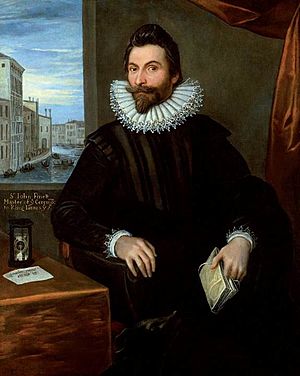John Finet facts for kids
Sir John Finet (1571–1641) was an important person in the English royal court during the Stuart period. He held the special job of Master of the Ceremonies, which meant he was in charge of welcoming foreign visitors and making sure royal events ran smoothly.
Contents
Who Was Sir John Finet?
Sir John Finet was born in 1571. His father was Robert Finet from a place called Soulton in Kent. His mother, Alice, came from a family whose father was a captain in Calais.
Sir John's great-grandfather, also named John Finet, originally came from Siena, Italy, in 1519. He arrived in England with a special visitor, Cardinal Campeggio. This John Finet decided to stay in England and married a lady named Mantell, who was a maid of honour to Queen Catherine of Aragon.
Life as a Diplomat and Courtier
Sir John Finet traveled a lot for his work. In early 1610, he was in Paris, France. He even wrote a report about how duels (fights between two people) were handled there. From 1609 to 1611, he traveled through southern France and northern Italy with William Cecil, who would later become the 2nd Earl of Salisbury. While in Venice, a famous artist named Domenico Tintoretto painted his picture.
Finet also worked for Robert Cecil, a very powerful person at court. In 1614, he went to Spain to give gifts of armor and animals to the Spanish royal family. The next year, he was with King James I in Cambridge.
Becoming Master of Ceremonies
On March 23, 1616, John Finet was made a knight, which meant he was called "Sir John." In 1619, he was chosen to take over the job of Master of the Ceremonies after Sir Lewes Lewknor retired or passed away. Finet had already started helping Lewknor with his duties. He officially took over the main role on March 12, 1626.
As Master of Ceremonies, Sir John Finet's main job was to welcome and entertain foreign visitors, like ambassadors, at the English court. He also had to solve many arguments about who should be placed first at events, which was called "precedence."
A Witty Courtier
Sir John Finet was known for being witty and entertaining. He would often sing funny songs for King James I after dinner, along with another courtier named Edward Zouch. However, sometimes his humor got him into trouble.
In 1618, he upset King James during a play put on by courtiers at Theobalds House. The play was meant to cheer up the King, who was suffering from gout (a painful joint condition). Sir John Finet sang some verses that the King found inappropriate. People at the time were surprised that no one realized how unsuitable it was to perform such things in front of the King.
Sir John Finet's Family Life
In 1618, Sir John Finet married Jane Wentworth. She was the daughter of Henry, Lord Wentworth. Her brother, Thomas Wentworth, later became the Earl of Cleveland.
Sir John and Jane had several children:
- John Finet
- Lucy Finet
- Finetta Finet, who lived to be 84 years old but never married.
- Anna Finet, who married Oliver Ivye.
- Elizabeth Finet, who married Thomas Morton and later someone from the Godscall family.
- Jane Finet, who married Richard Everard.
Sir John Finet also had a sister named Joan Finet. She was a maid of honour to Queen Anne of Denmark, King James I's wife. Joan married Thomas Foche.
Sir John Finet passed away on July 12, 1641, when he was 70 years old. He was buried in the church of St. Martin's-in-the-Fields in London. After his death, Sir Charles Cotterell took over his important role as Master of Ceremonies.
Sir John Finet's Writings
Sir John Finet was also an author. He wrote or translated a few books:
- The Beginning, Continvance, and Decay of Estates (1606): This book was originally written in French by R. de Lusing and translated into English by Finet. It was an essay about the history of the Turks in Europe.
- Finetti Philoxenis (1656): This book was published after his death. It contained Sir John Finet's observations and notes about how foreign ambassadors were welcomed and treated in England. It also covered the rules of precedence and the arguments that sometimes happened between them. The book mainly described events during the reign of King James I.
Some of Sir John Finet's letters can still be found today in important collections, like those belonging to the Duke of Devonshire and at Hatfield House. He even had some recipes in a old manuscript book!
Images for kids



